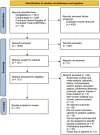Surgical revascularizations for pediatric moyamoya: a systematic review, meta-analysis, and meta-regression analysis
- PMID: 36752913
- PMCID: PMC10167165
- DOI: 10.1007/s00381-023-05868-6
Surgical revascularizations for pediatric moyamoya: a systematic review, meta-analysis, and meta-regression analysis
Abstract
Introduction: There is no clear consensus regarding the technique of surgical revascularization for moyamoya disease and syndrome (MMD/MMS) in the pediatric population. Previous meta-analyses have attempted to address this gap in literature but with methodological limitations that affect the reliability of their pooled estimates. This meta-analysis aimed to report an accurate and transparent comparison between studies of indirect (IB), direct (DB), and combined bypasses (CB) in pediatric patients with MMD/MMS.
Methods: In accordance with PRISMA guidelines, systematic searches of Medline, Embase, and Cochrane Central were undertaken from database inception to 7 October 2022. Perioperative adverse events were the primary outcome measure. Secondary outcomes were rates of long-term revascularization, stroke recurrence, morbidity, and mortality.
Results: Thirty-seven studies reporting 2460 patients and 4432 hemispheres were included in the meta-analysis. The overall pooled mean age was 8.6 years (95% CI: 7.7; 9.5), and 45.0% were male. Pooled proportions of perioperative adverse events were similar between the DB/CB and IB groups except for wound complication which was higher in the former group (RR = 2.54 (95% CI: 1.82; 3.55)). Proportions of post-surgical Matsushima Grade A/B revascularization favored DB/CB over IB (RR = 1.12 (95% CI 1.02; 1.24)). There was no significant difference in stroke recurrence, morbidity, and mortality. After meta-regression analysis, year of publication and age were significant predictors of outcomes.
Conclusions: IB, DB/CB are relatively effective and safe revascularization options for pediatric MMD/MMS. Low-quality GRADE evidence suggests that DB/CB was associated with better long-term angiographic revascularization outcomes when compared with IB, although this did not translate to long-term stroke and mortality benefits.
Keywords: Bypass; Moyamoya disease; Moyamoya syndrome; Neurosurgery; Pediatric; Revascularization.
© 2023. The Author(s).
Conflict of interest statement
The authors declare that they have no conflict of interest.
Figures



References
-
- Scott RM et al (2004) Long-term outcome in children with moyamoya syndrome after cranial revascularization by pial synangiosis. J Neurosurg 100(2 Suppl Pediatrics):p. 142–9 - PubMed
-
- Matsushima T et al (1998) Multiple combined indirect procedure for the surgical treatment of children with moyamoya disease. A comparison with single indirect anastomosis and direct anastomosis. Neurosurg Focus 5(5):p. e4 - PubMed
Publication types
MeSH terms
Grants and funding
LinkOut - more resources
Full Text Sources
Medical
Miscellaneous

